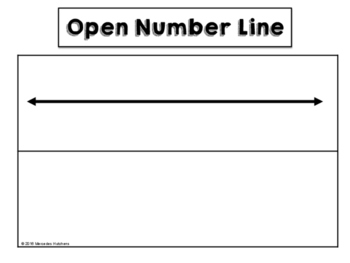Mercedes Hutchens
7.3k Followers
Grade Levels
1st - 4th, Homeschool
Subjects
Resource Type
Standards
CCSS1.NBT.B.2
CCSS1.OA.A.1
CCSS2.OA.A.1
CCSS3.NF.A.2
CCSS4.NF.A.2
Formats Included
- PDF
Pages
9 pages
Mercedes Hutchens
7.3k Followers
Description
This work mat can be used for any number line activity. You can laminate it for use with white board markers or wet erase markers. Another option is to insert them into reusable dry erase pockets.
An Open Number Line can be used for:
*place value
*addition
*subtraction
*two digit addition
*two digit subtraction
*fractions
*decimals
*multiplying
*comparing
*creating a visual to solve word problems
The version with two number lines is helpful for comparing. The version with one number line leaves room for writing an equation.
As an intervention teacher, I’ve used this for a variety of activities. I’ve taught my 1st graders place value by hopping to target numbers. I’ve also taught my 5th graders to add fractions with unlike denominators. I hope you’ll find this as useful as I have.
An Open Number Line can be used for:
*place value
*addition
*subtraction
*two digit addition
*two digit subtraction
*fractions
*decimals
*multiplying
*comparing
*creating a visual to solve word problems
The version with two number lines is helpful for comparing. The version with one number line leaves room for writing an equation.
As an intervention teacher, I’ve used this for a variety of activities. I’ve taught my 1st graders place value by hopping to target numbers. I’ve also taught my 5th graders to add fractions with unlike denominators. I hope you’ll find this as useful as I have.
Total Pages
9 pages
Answer Key
N/A
Teaching Duration
N/A
Last updated Nov 26th, 2016
Report this resource to TPT
Reported resources will be reviewed by our team. Report this resource to let us know if this resource violates TPT’s content guidelines.
Standards
to see state-specific standards (only available in the US).
CCSS1.NBT.B.2
Understand that the two digits of a two-digit number represent amounts of tens and ones. Understand the following as special cases:
CCSS1.OA.A.1
Use addition and subtraction within 20 to solve word problems involving situations of adding to, taking from, putting together, taking apart, and comparing, with unknowns in all positions, e.g., by using objects, drawings, and equations with a symbol for the unknown number to represent the problem.
CCSS2.OA.A.1
Use addition and subtraction within 100 to solve one- and two-step word problems involving situations of adding to, taking from, putting together, taking apart, and comparing, with unknowns in all positions, e.g., by using drawings and equations with a symbol for the unknown number to represent the problem.
CCSS3.NF.A.2
Understand a fraction as a number on the number line; represent fractions on a number line diagram.
CCSS4.NF.A.2
Compare two fractions with different numerators and different denominators, e.g., by creating common denominators or numerators, or by comparing to a benchmark fraction such as 1/2. Recognize that comparisons are valid only when the two fractions refer to the same whole. Record the results of comparisons with symbols >, =, or <, and justify the conclusions, e.g., by using a visual fraction model.





